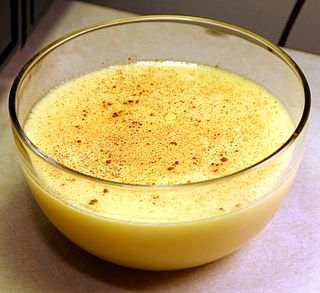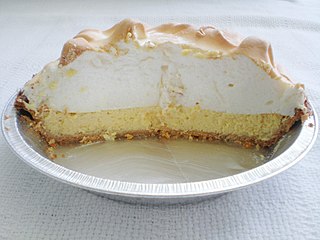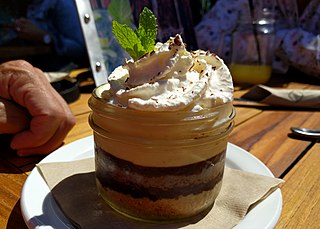
Dessert is a course that concludes a meal. The course consists of sweet foods, such as cake, biscuit, ice cream and possibly a beverage such as dessert wine and liqueur. Some cultures sweeten foods that are more commonly savory to create desserts. In some parts of the world there is no tradition of a dessert course to conclude a meal.

Custard is a variety of culinary preparations based on sweetened milk, cheese, or cream cooked with egg or egg yolk to thicken it, and sometimes also flour, corn starch, or gelatin. Depending on the recipe, custard may vary in consistency from a thin pouring sauce to the thick pastry cream used to fill éclairs. The most common custards are used in custard desserts or dessert sauces and typically include sugar and vanilla; however, savory custards are also found, e.g., in quiche.

A pie is a baked dish which is usually made of a pastry dough casing that contains a filling of various sweet or savoury ingredients. Sweet pies may be filled with fruit, nuts, fruit preserves, brown sugar, sweetened vegetables, or with thicker fillings based on eggs and dairy. Savoury pies may be filled with meat, eggs and cheese or a mixture of meat and vegetables.

Meringue is a type of dessert or candy, of French origin, traditionally made from whipped egg whites and sugar, and occasionally an acidic ingredient such as lemon, vinegar, or cream of tartar. A binding agent such as salt, flour or gelatin may also be added to the eggs. The key to the formation of a good meringue is the formation of stiff peaks by denaturing the protein ovalbumin via mechanical shear.

An apple pie is a pie in which the principal filling is apples. Apple pie is often served with whipped cream, ice cream, custard or cheddar cheese. It is generally double-crusted, with pastry both above and below the filling; the upper crust may be solid or latticed. The bottom crust may be baked separately ("blind") to prevent it from getting soggy. Deep-dish apple pie often has a top crust only. Tarte Tatin is baked with the crust on top, but served with it on the bottom.

Cheesecake is a dessert made with a soft fresh cheese, eggs, and sugar. It may have a crust or base made from crushed cookies, graham crackers, pastry, or sometimes sponge cake. Cheesecake may be baked or unbaked, and is usually refrigerated.

Key lime pie is an American dessert pie. It is made of lime juice, egg yolks, and sweetened condensed milk. It may be served with no topping, or with a meringue topping made from egg whites, or with whipped cream. It may be cooked in a pie crust, graham cracker crust, or no crust. The dish is named after the small Key limes, which are more aromatic than the common Persian limes, and which have yellow juice. The filling in a Key lime pie is typically yellow because of the egg yolks.

A custard pie is any type of uncooked custard mixture placed in an uncooked or partially cooked crust and baked together. In North America, "custard pie" commonly refers to a plain mixture of milk, eggs, sugar, salt, vanilla extract and sometimes nutmeg combined with a pie crust. It is distinctly different from a cream pie, which contains cooked custard poured into a cooled, precooked crust. In the United Kingdom, the comical or political act of pieing is conventionally done with a "custard pie". Some common custard pies include pumpkin pie, lemon and buttermilk chess pie, coconut cream pie, and buko pie. True custard is defined as a liquid thickened with eggs. The often large number of whole eggs in custard pie make it very rich.

Lemon ice box pie is an icebox pie consisting of lemon juice, eggs, and condensed milk in a pie crust, frequently made of graham crackers and butter. It is a variant of key lime pie; in both, the citric acidity sets the egg yolks, with minimal baking. There are also no bake versions.

A cream pie, crème pie, or creme pie is a type of pie filled with a rich custard or pudding that is made from milk, cream, sugar, wheat flour, and eggs and typically topped with whipped cream.

Fruit curd is a dessert spread and topping. It is usually made with citrus fruit, though may be made with other fruits. Curds are often used as spreads and as flavourings.

A lemon tart is a dessert dish, a variety of tart. It has a pastry shell with a lemon flavored filling.

Graham cracker crust is a style of pie crust made from crushed graham crackers. Graham crackers are a sweet American cracker made from unbleached, whole wheat graham flour. The crust is usually flavored and stiffened with butter or vegetable oil and sometimes sugar. Graham cracker crust is a very common type of crust for cheesecakes and cream pies in America.

Sponge cake is a light cake made with eggs, flour and sugar, sometimes leavened with baking powder. Some sponge cakes do not contain egg yolks, like angel food cake, but most of them do. Sponge cakes, leavened with beaten eggs, originated during the Renaissance, possibly in Spain. The sponge cake is thought to be one of the first non-yeasted cakes, and the earliest attested sponge cake recipe in English is found in a book by the English poet Gervase Markham, The English Huswife, Containing the Inward and Outward Virtues Which Ought to Be in a Complete Woman (1615). Still, the cake was much more like a cracker: thin and crispy. Sponge cakes became the cake recognised today when bakers started using beaten eggs as a rising agent in the mid-18th century. The Victorian creation of baking powder by English food manufacturer Alfred Bird in 1843 allowed the addition of butter to the traditional sponge recipe, resulting in the creation of the Victoria sponge. Cakes are available in many flavours and have many recipes as well. Sponge cakes have become snack cakes via the Twinkie.

Black bottom pie is a type of pie originating in the United States that features a layer of chocolate pastry cream or pudding, the "black bottom", topped with whipped cream or meringue. The single crust is pre-baked and of variable composition, but a graham cracker crust is common.
Pie in American cuisine has roots in English cuisine and has evolved over centuries to adapt to American cultural tastes and ingredients. The creation of flaky pie crust shortened with lard is credited to American innovation.
Angel pie is a class of pies in American cuisine made with a meringue pie shell. There are many different fillings that can be used to make angel pie.
Monroe Boston Strause was an American piemaker whose innovations included graham-cracker crust, chiffon pie, and black-bottom pie. He was a "pie celebrity" whose name was "a household word."
Icebox pies are no-bake pies including ice cream pies, chiffon pies, and classic cream pies like key lime pie, lemon ice box pie, chocolate pudding pie, grasshopper pie and banana cream pie. The crust can be a crumb crust or blind baked pastry. They are associated with the cuisine of the Southern United States.
















